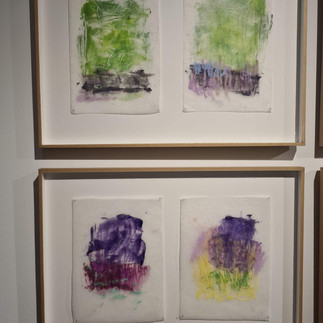"In the Time of Women: Monique Frydman's Artful Revolution"
- Zoe Chambers

- Oct 16, 2023
- 3 min read

PARIS.FRANCE.
September unfurled as a month of vibrant artistry in the bustling heart of Paris. Galleries across the city flung open their doors to unveil a plethora of exhibitions and vernissages, celebrating the boundless creativity of female artists.
Amongst these luminaries, the name Monique Frydman might have remained shrouded in obscurity for many non Parisians, yet her legacy is a sprawling canvas teeming with profound narratives and captivating works.
Frydman's latest exhibition, hosted at the esteemed Dutko Gallery, revealed an intricate tapestry of her oeuvre, with individual pieces spanning a remarkable price range from thousands to hundreds of thousands of euros, a testament to her enduring influence in the art world.
Monique Frydman's stature as a major abstract painter rests not only on her artistic prowess but also on the remarkable journey of her life. Born in the picturesque town of Nages in the Occitan region of South West France to a Ukrainian father and a Lithuanian mother, Frydman's early years were immersed in the world of art. She graduated from the Art School of Toulouse and, in 1964, made Paris her artistic home, continuing her creative journey at the Beaux-Arts in the French capital.
Amidst the turbulence of the late '60s, when France was caught in the whirlwind of political movements, including the fervor of May '68, feminism, and the rise of the extreme left, Monique Frydman, alongside her husband, the gynecologist Dr. Rene Frydman, took a revolutionary stand for women's rights, freedom, and contraception. At this juncture, she momentarily paused her painting career to become a teacher of drawing. However, her passion for art never dimmed, and she gradually transitioned from figurative painting to abstract, even as many artists explored new mediums and performance art. Frydman remained steadfast in her dedication to traditional painting on canvas and paper, her fascination with Japanese silk paper becoming an enduring hallmark. Her technique involved the meticulous integration of silk paper with drawings on canvas, expertly separating color from form.
In the early '80s, Frydman's artistic horizons expanded as she ventured into large format canvases. Her palette, once infused with dark charcoal, transformed into an explosion of vibrant colors inspired by her travels to Australia and India. The '90s witnessed her experimentation with various techniques, including an "Asian style" approach with glue and pigment, as well as the daring blind technique, where she created abstract works through blindfolded movements on canvas.
Throughout her illustrious career, Frydman found representation in numerous galleries worldwide and graced the walls of museums and contemporary art centers with her creations. The apex of her journey can be symbolized by the remarkable "Polyptyque Sassetta" exhibition at the Louvre Museum's Salon Carré, an achievement that only few artists can boast.
The current exhibition of Monique Frydman, masterfully curated by Galerie Dutko, is a testament to her ever-evolving artistry. Comprising works crafted between 2022 and 2023, this collection, titled "L'Autre Rive," presents a departure from her previous use of pastels. Here, pastels are more diluted and lighter, while Frydman employs her brushwork to refine the marks left by pastel blocks. The result is a series of canvases imbued with the delicate qualities of watercolors.
Dutko Gallery, a bastion of contemporary art, provides a fitting backdrop for the exhibition. Nestled at Quai Voltaire, just a stone's throw away from the Musee d'Orsay and the Beaux-Arts Academy, the gallery's history is steeped in art and design. Originally founded in 1969 with a focus on Art Deco furniture, it evolved under the stewardship of Jean-Jacques Dutko, championing the interplay between artists' furniture, sculpture, and painting. In 2010, the gallery expanded to Rue de Bretonvilliers on the Ile Saint-Louis, marking a pivotal shift towards contemporary art. Today, Dutko Gallery stands as a central hub for both established and emerging artists, who showcase their creations in solo and group exhibitions, both nationally and internationally.
































Comments